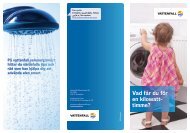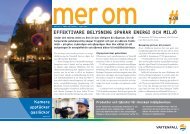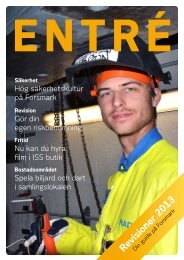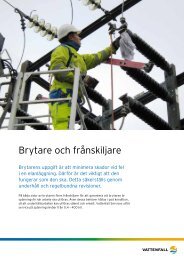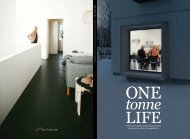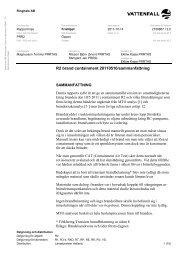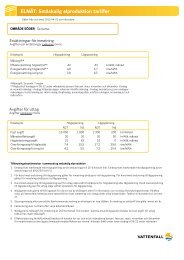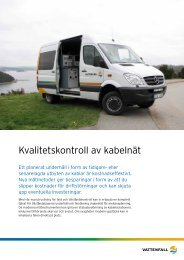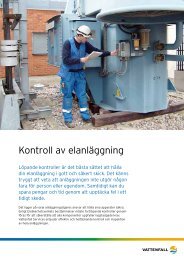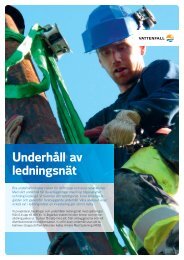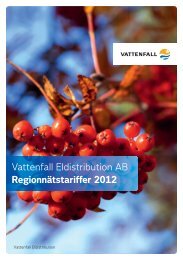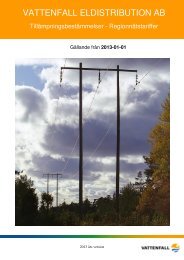This environmental impact assessment for Kriegers flak ... - Vattenfall
This environmental impact assessment for Kriegers flak ... - Vattenfall
This environmental impact assessment for Kriegers flak ... - Vattenfall
Create successful ePaper yourself
Turn your PDF publications into a flip-book with our unique Google optimized e-Paper software.
During the construction phase, the entire site including<br />
a 500 metre security zone will be suspended. A<br />
suspension notice will be sent to Ufs (Notices <strong>for</strong><br />
seafarers) and the area will be laid out in navigational<br />
charts. Radio messages about the suspension will be<br />
relayed at several times.<br />
5.6.3. The operational phase<br />
The wind turbines will function automatically and<br />
will produce electricity at wind speeds between 3,5<br />
and 30 m/s. At wind speeds above 30 m/s the pitch of<br />
the blades will adjust to a 0 degree angle causing the<br />
turbines to stop rotating until the wind speed again is<br />
lower that 30 m/s.<br />
The wind turbines will be operated from an onshore-based<br />
operation centre. The inbuilt control<br />
systems will detect problems early and will send error<br />
messages to the op-centre. It will be possible to switch<br />
on or off turbines from the op-centre. Communication<br />
will be established through an opto cable that will be<br />
integrated with the main electrical cable. A satellite<br />
backup system will also be available should the opto<br />
cable fail.<br />
All operational data will be registered in the op-centre.<br />
Personnel will man the op-centre around the clock.<br />
The following systems will be monitored:<br />
• The wind turbines<br />
• The infrastructure (cables and foundations)<br />
• Nautical security systems<br />
• Air security systems (bulbs on the wind turbines etc)<br />
The trans<strong>for</strong>mer stations that register storms, Þ re<br />
etc., will, in addition, be monitored.<br />
The monitoring system in the op-centre must be<br />
able to determine where a potential fault has occurred<br />
as well as the scale thereof.<br />
Through this constant monitoring, faults and problems<br />
should be cured or limited be<strong>for</strong>e serious damage<br />
has occurred.<br />
The wind turbine suppliers will, once or twice per<br />
DESCRIPTION OF THE WIND FARM 33<br />
year, carry out inspections and service on the turbines.<br />
During these visits, among other service tasks, a<br />
change of oil Þ lters takes place. The oil in the gearbox<br />
is changed every 2 – 3 years.<br />
To assist during emergencies, the turbines will each<br />
have a bedroom equipped with Þ rst aid kits, food, life<br />
buoys, lifelines, duvets, Þ re extinguishers and Þ re<br />
alarms. There will also be communication devices with<br />
direct links to rescue stations onshore. The room can<br />
also be used by service men that need to stay on the<br />
turbines to carry out extended repairs or maintenance<br />
work.<br />
It will be possible to board each wind turbine by<br />
ship and there will be equipment installed to allow<br />
personnel to climb up onto the turbine by themselves<br />
from the water level.<br />
Security and survival training relating to the special<br />
risks associated with work offshore will be given to all<br />
service personnel.<br />
The wind turbines will be operated in accordance<br />
with current health, environment, rescue, electrical<br />
safety and work environment regulations.<br />
5.6.4. The dismantling phase<br />
The operational phase is expected to last <strong>for</strong> 30 years.<br />
Following the operational phase, the wind turbines as<br />
well as most of the infrastructure installations, will<br />
be dismantled. To avoid uncontrollable leakage, any<br />
<strong>environmental</strong>ly hazardous ß uids (such as oils) will<br />
be removed be<strong>for</strong>e the turbines are dismantled. The<br />
section of the foundation that is situated further than<br />
one metre into the seabed will be left after dismantling.<br />
A plan <strong>for</strong> recycling will be drawn up and all parts that<br />
can (e.g. steel and copper parts), will be recycled. The<br />
work will be quality guaranteed.<br />
When the construction phase starts, to ensure that<br />
the dismantling actually will take place, the operator<br />
will put up a surety <strong>for</strong> the dismantling costs in the<br />
<strong>for</strong>m of a bank guarantee.




